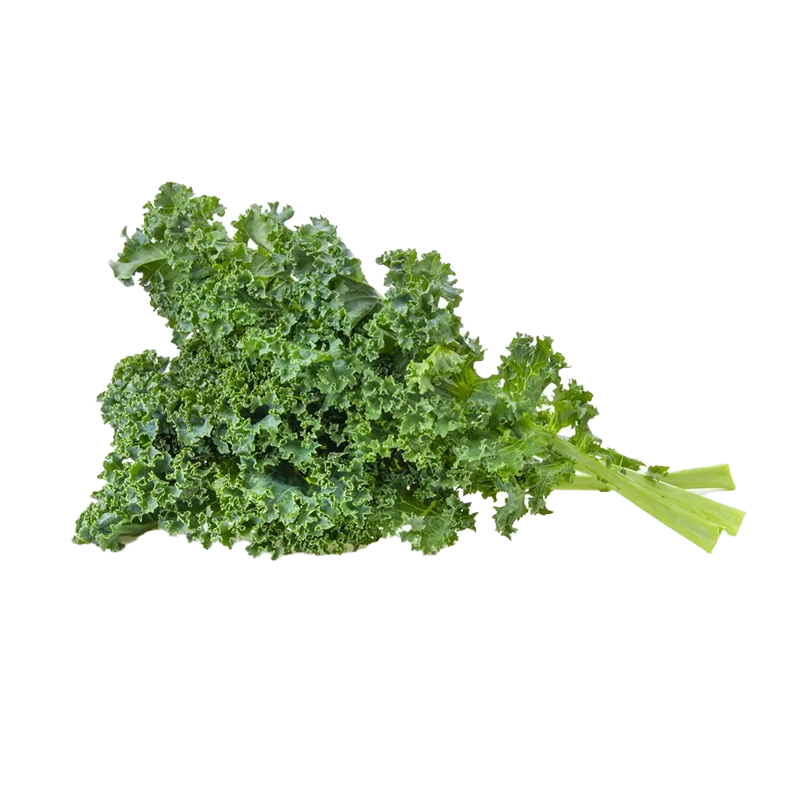Kale — Nutrients, Health Benefits, And Shopping Tips

Written by Listonic Team
Last update on September 4, 2024
Nutrition facts
Nutrition facts
Amount per 100 g
Calories
🔥 49 kcal
| Nutrition per: 100 g | Value | % Daily Value* |
|---|---|---|
| Carbs | 9 g | 3.27% |
| Fiber | 4 g | 14.29% |
| Sugars | 2 g | 4% |
| Glycemic Index | 50 | - |
| Protein | 4 g | 8% |
| Sodium | 38 mg | 1.65% |
| Total Fat | 1 g | 1.28% |
*The % of Daily Value (DV) tells you how much a nutrient in a serving of food contributes to a daily diet. 2,000 calories a day is used for general nutrition advice.
50
🟢 Low Glycemic Index
1 g
🥕 Low Fat Content
Did you know?
Health benefits
- Extremely nutrient-dense, providing a high amount of vitamins A, C, and K, as well as folate, iron, and calcium.
- Rich in antioxidants such as quercetin and kaempferol, which help protect the body from free radicals and reduce inflammation.
- High in fiber, promoting digestive health, regular bowel movements, and a healthy gut microbiome.
- Contains cancer-fighting compounds like sulforaphane and indole-3-carbinol, which have been shown to help reduce the risk of cancer.
Health risks
- Potential for digestive discomfort such as bloating or gas when consumed in large quantities, particularly for individuals sensitive to high-fiber foods.
- Risk of thyroid function disruption in individuals with thyroid issues, as kale contains goitrogens, compounds that can interfere with thyroid hormone production when consumed in very large amounts.
- Potential for contamination with harmful bacteria or pesticides if not properly washed or sourced from a reputable supplier.
- Oxalate content in kale may contribute to kidney stone formation in susceptible individuals when consumed in large quantities.
How to choose kale
Kale should have dark, lush green leaves that are firm and deeply textured. The leaves should feel sturdy and spring back when touched.
Pass over kale that is yellowing or has limp, thin leaves, which indicate it is past its prime. Fresh kale will be nutrient-rich and have a robust flavor, ideal for salads, smoothies, and cooked dishes.

How to store kale
Kale should be stored in the refrigerator's crisper drawer. Placing it in a plastic bag helps retain its crispness and nutritional value. Properly stored, kale remains fresh and ready for salads and cooking.
Leaving kale unprotected can lead to wilting and spoilage. Washing it before storage can introduce excess moisture, which is not recommended. Keeping it dry and cool helps maintain its texture and extends its shelf life.
✅ Extra Tip
How long does it last?
Kale can last for 5-7 days in the refrigerator when stored in a plastic bag or container. For longer storage, kale can be blanched and frozen, lasting up to 12 months.
What to do with leftovers?
Leftover kale can be used in a variety of healthy and flavorful dishes. Chop it and add to salads with other greens, vegetables, and a tangy vinaigrette, or sauté it with garlic and olive oil for a simple and nutritious side dish. Kale is also great when added to smoothies, where its mild flavor blends well with fruits like bananas, berries, and apples.
Use kale in a stir-fry with other vegetables and a protein of your choice, or mix it into a soup or stew for added nutrition. If you have a lot of kale, consider making a batch of kale chips by tossing the leaves with olive oil and baking until crispy. Kale can also be added to a grain bowl with quinoa or rice, or used as a base for a pasta dish with garlic, chili flakes, and Parmesan cheese. For a quick snack, try massaging kale with lemon juice and olive oil to soften the leaves, then tossing with nuts, seeds, and dried fruit for a hearty salad.
👨⚕️️ Medical disclaimer
Discover products from other categories
Listonic Team
Fact-checked
Our editorial team checked this article to make sure it was accurate at the time of publishing it.
Get the top-rated shopping list app on your phone!







